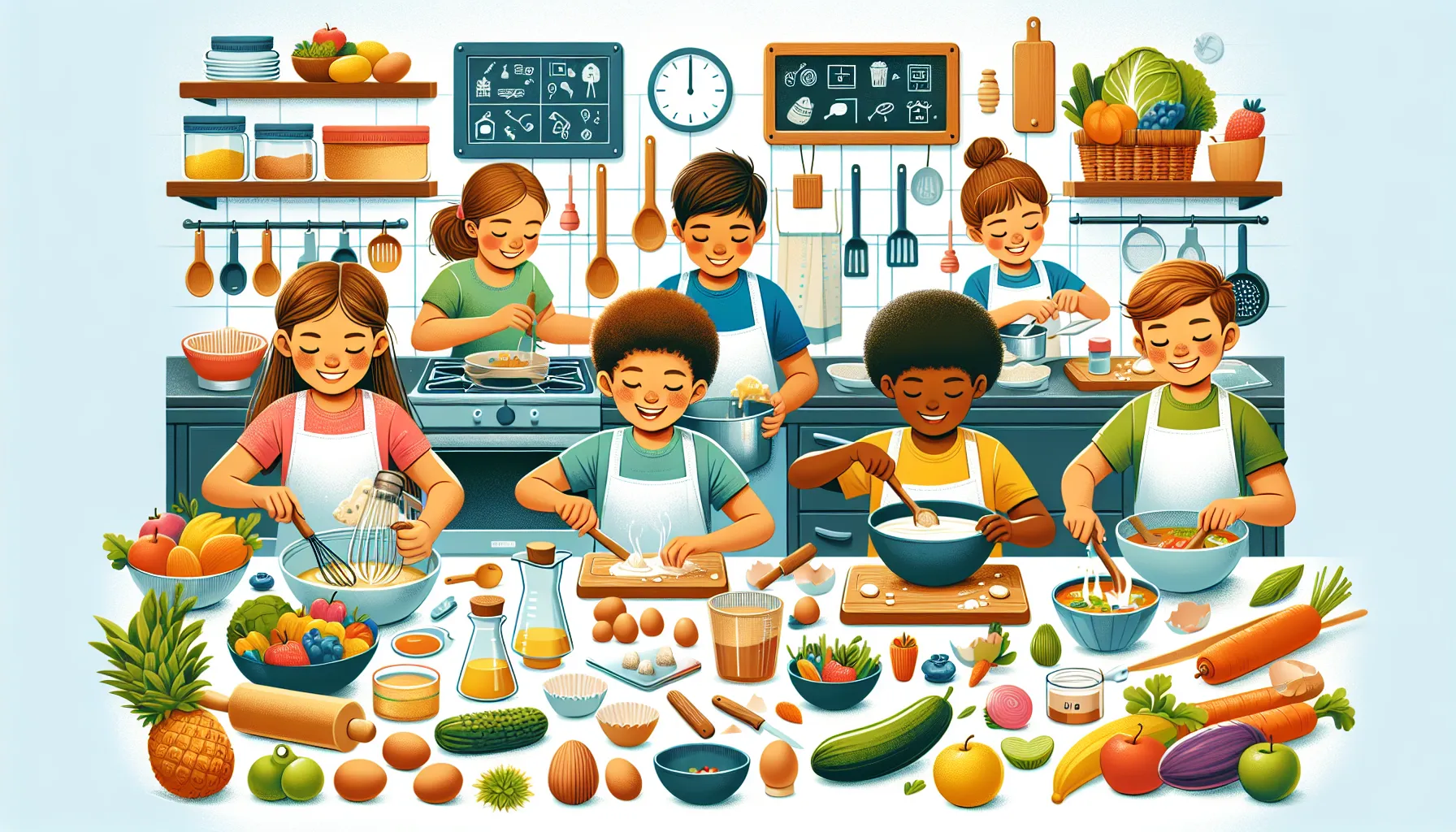
Key Takeaways
- Kids cooking vocabulary worksheets make learning fun by combining language development with hands-on cooking activities.
- These worksheets introduce essential culinary terms like “whisk,” “knead,” and “sauté,” building both vocabulary and kitchen confidence.
- Interactive elements like matching games, fill-in-the-blank exercises, and visual aids engage kids and make concepts easier to understand and retain.
- Pairing worksheets with practical cooking tasks helps children connect vocabulary to real-world actions, enhancing comprehension and memory.
- Selecting age-appropriate, engaging worksheets ensures steady learning progress and keeps kids motivated.
- Creative approaches, such as integrating games or creating recipe cards, foster curiosity and encourage kids to apply new words in meaningful ways.
Cooking opens up a world of creativity and learning for kids, and language plays a big part in that journey. Have you ever noticed how many new terms pop up when following a recipe? From “whisk” to “simmer,” understanding cooking vocabulary helps kids feel more confident and engaged in the kitchen. It’s more than just words—it’s about building skills and sparking curiosity.
We know how important it is to make learning fun and approachable. Cooking vocabulary worksheets offer a hands-on way for kids to connect with these terms while enjoying the process. They can practice reading, comprehension, and even problem-solving, all while exploring the joys of cooking. How can we make these moments both educational and exciting? By turning everyday recipes into opportunities to learn and grow together.
Importance Of Teaching Kids Cooking Vocabulary
Cooking vocabulary helps kids build confidence and independence in the kitchen. Words like “knead,” “dice,” and “sauté” open doors to better understanding recipes and mastering essential techniques. With the right tools, children can grasp these terms while enjoying the process.
Learning cooking-related words encourages language development. Kids practice reading and pronunciation, expanding their vocabulary and comprehension skills. This contributes to both their culinary knowledge and overall communication abilities.
We make cooking enjoyable and educational by focusing on interactive learning. Worksheets and activities focused on cooking terms allow kids to connect words with actions like chopping or mixing. This hands-on approach helps retain information while keeping them engaged.
Incorporating vocabulary into kitchen time strengthens problem-solving skills. When kids identify tools or follow specific steps, they develop critical thinking. Terms like “preheat” introduce logic, connecting actions to outcomes in a tangible way.
Baking and cooking naturally combine with science and math. As children measure ingredients or observe chemical reactions (e.g., baking powder creating bubbles), they see how vocabulary ties into these subjects, broadening their understanding while enhancing classroom knowledge.
Teaching this vocabulary fosters a love for cooking through meaningful interactions. Engaging kids in worksheets tied to their favorite recipes transforms learning into bonding moments. What’s their favorite food to make?
Benefits Of Kids Cooking Vocabulary Worksheets

Kids cooking vocabulary worksheets combine fun with education, offering children an engaging way to develop valuable skills. These worksheets go beyond just learning words; they inspire creativity and build deeper connections with the cooking process.
Enhancing Language Skills
Cooking vocabulary introduces children to words like “whisk,” “simmer,” and “knead.” Associating these terms with actions strengthens comprehension and pronunciation. Worksheets often include matching activities or fill-in-the-blanks, helping kids recognize and apply new words effectively. They practice reading and following instructions, laying a solid foundation for future communication skills.
Promoting Culinary Knowledge
While learning words, children gain insight into techniques that improve their kitchen confidence. Terms such as “dice” and “sauté” teach essential cooking methods in simple ways. Worksheets allow young learners to translate vocabulary into practical steps, bridging the gap between knowing and doing. This boosts familiarity with culinary tools, processes, and ingredient preparation.
Encouraging Hands-On Learning
Interactive worksheets connect words to real tasks, making education more dynamic. Kids might trace words, classify terms by category, or match definitions, reinforcing knowledge through repetition. When paired with actual cooking, these activities create memorable experiences. This hands-on approach supports curiosity and builds self-reliance, encouraging kids to experiment and enjoy the journey of learning.
Features Of Effective Kids Cooking Vocabulary Worksheets

Effective kids cooking vocabulary worksheets combine learning with fun, making it easier for children to understand and retain new words. They encourage curiosity and hands-on participation in the kitchen.
Age-Appropriate Vocabulary
Content in these worksheets uses words suited to the age and comprehension level of kids. For younger children, simpler terms like “mix,” “bake,” or “stir” work best. For older kids, more advanced vocabulary like “knead” or “whisk” adds a challenge. Matching vocabulary complexity with age helps kids feel confident and keeps them engaged.
Interactive And Engaging Activities
The most effective worksheets integrate activities like word searches, matching tasks, and fill-in-the-blanks connected to cooking scenarios. For instance, kids could match a picture of a whisk to its word or complete sentences like, “To bake a cake, first you ______ the eggs.” These activities create a sense of accomplishment while encouraging learning through play.
Visual Aids And Illustrations
Visual elements, such as colorful illustrations of tools like rolling pins or bowls, enhance understanding. Charts showing step-by-step visuals for actions like “dice” or “measure” clarify meanings for young learners. Bright, engaging images make learning appealing and help kids remember vocabulary better.
Popular Types Of Kids Cooking Vocabulary Worksheets
Kids cooking vocabulary worksheets can make learning new words entertaining and practical. By connecting language with activities, these worksheets help children absorb concepts while staying engaged. What methods excite your child most when it comes to learning?
Matching Games And Flashcards
Matching games and flashcards simplify vocabulary practice. Children pair words like “slice” or “stir” with corresponding images or definitions, reinforcing their understanding. Flashcards offer flexibility—kids can practice solo or compete with others for an interactive twist. These tools support memory retention and create a fun way to build vocabulary fluency.
Fill-In-The-Blank Exercises
Fill-in-the-blank exercises challenge kids to apply cooking vocabulary in context. Sentences such as, “Use a __________ to mix the batter,” encourage them to think critically. These activities link words to real-world scenarios, making processes like “whisking” or “baking” relatable. They also enhance reading comprehension, as kids decode clues for the correct answers.
Crossword And Word Search Activities
Crosswords and word searches turn learning into a puzzle-solving adventure. Kids discover terms like “knead,” “dice,” or “simmer” by searching grids or solving clues. These activities build focus and problem-solving skills while introducing new vocabulary in a format children enjoy. Vibrant designs add to the excitement, motivating kids to revisit learning sessions.
Tips For Using Kids Cooking Vocabulary Worksheets At Home
Using cooking vocabulary worksheets can be highly rewarding when incorporated into your child’s daily activities. By combining them with hands-on experiences and creative approaches, kids can learn skills while enjoying the process.
Integrating Worksheets With Practical Cooking
Pair worksheets with real recipes to reinforce understanding. Introducing terms like “chop” or “whisk” in an instructional context helps solidify knowledge. For example, try reviewing related vocabulary before starting a simple recipe together. As your child encounters actions in the recipe, they’ll naturally connect the words to real tasks. This integration fosters better memory retention and creates a meaningful connection between learning and doing.
Consider discussing new words while gathering ingredients. If a worksheet mentions “sift” or “dice,” demonstrate the action during the activity. Let children try it themselves to deepen comprehension. Engaging in this manner makes learning part of the experience, not a separate chore.
Choosing Worksheets Based On Skill Levels
Select worksheets that match your child’s age and language ability. Younger kids might engage better with simple matching tasks or picture-based worksheets, while older children could benefit from crossword puzzles or fill-in-the-blank exercises. Gradually introducing more challenging vocabulary keeps learning engaging without overwhelming them.
Think about your child’s familiarity with cooking concepts. If they’re new to cooking terms, start with common words like “mix” or “bake.” For kids with more experience, include advanced vocabulary such as “knead” or “simmer.” Adapting the complexity helps maintain interest and supports steady progress.
Encouraging Fun And Creativity
Make the worksheet experience enjoyable by incorporating games or rewards. Turn a vocabulary task into a scavenger hunt, where kids find matching items in the kitchen. Adding playful elements transforms learning into a fun bonding opportunity.
Motivate children to create their own recipe cards using new vocabulary. Ask them to describe each step, using words they’ve learned. This encourages expression and creativity while reinforcing their understanding. Plus, it builds confidence in using cooking terms. By combining structured worksheets with fun activities, kids develop skills in a supportive environment that feels exciting and approachable.
Conclusion
Kids cooking vocabulary worksheets offer a unique way to blend education with creativity, turning everyday kitchen activities into exciting learning opportunities. By introducing essential cooking terms through engaging and interactive methods, we can spark curiosity and build valuable skills that go beyond the kitchen.
When we pair worksheets with hands-on experiences, children gain confidence, independence, and a deeper understanding of both language and culinary concepts. It’s a fun, practical approach that encourages learning while creating lasting memories. Let’s inspire a love for cooking and learning, one worksheet at a time!
Frequently Asked Questions
Why is teaching kids cooking vocabulary important?
Teaching kids cooking vocabulary helps them understand essential techniques, build confidence, and improve language skills. It connects words to actions, promotes independence, and transforms cooking into an engaging educational activity.
How do cooking vocabulary worksheets benefit children?
Cooking vocabulary worksheets make learning interactive and fun by combining language development with hands-on tasks. They enhance comprehension, boost problem-solving skills, and encourage curiosity about cooking and other subjects like science and math.
What should a good kids cooking vocabulary worksheet include?
Effective worksheets should feature age-appropriate vocabulary, interactive tasks like word searches or matching games, and visual aids to enhance understanding and retention, making learning enjoyable and memorable.
What types of activities are included in cooking vocabulary worksheets?
Worksheets often include matching games, crossword puzzles, word searches, flashcards, and fill-in-the-blank exercises. These activities promote critical thinking, engagement, and vocabulary retention while making learning fun.
How can I use cooking vocabulary worksheets at home?
Pair worksheets with real recipes, discuss new words while cooking, and let kids practice actions like “whisk” or “knead.” Choose age-appropriate materials and incorporate games or rewards for a fun, educational experience.
Can cooking vocabulary worksheets improve problem-solving skills?
Yes, cooking vocabulary worksheets improve problem-solving skills by encouraging kids to apply words to real-life cooking tasks, measure ingredients, and explore concepts tied to science and math.
Are cooking vocabulary worksheets suitable for all ages?
Yes, worksheets can be tailored to different age groups by adjusting vocabulary difficulty and activities. Younger kids can use simple matching games, while older kids benefit from more complex tasks like word puzzles.
How can I make learning cooking vocabulary fun for kids?
Incorporate games, rewards, and hands-on activities like scavenger hunts or recipe creation. Use colorful worksheets and engage kids in discussions during cooking to deepen understanding and maintain excitement.
What’s the best way to reinforce cooking vocabulary?
Reinforce vocabulary by practicing words during real cooking sessions, using flashcards, and encouraging kids to repeat and demonstrate actions. Consistent use helps solidify their understanding and builds confidence.
Can cooking vocabulary tie into other learning subjects?
Absolutely! Cooking vocabulary supports learning in subjects like math (measuring ingredients) and science (understanding chemical reactions), making cooking a cross-functional educational experience.

